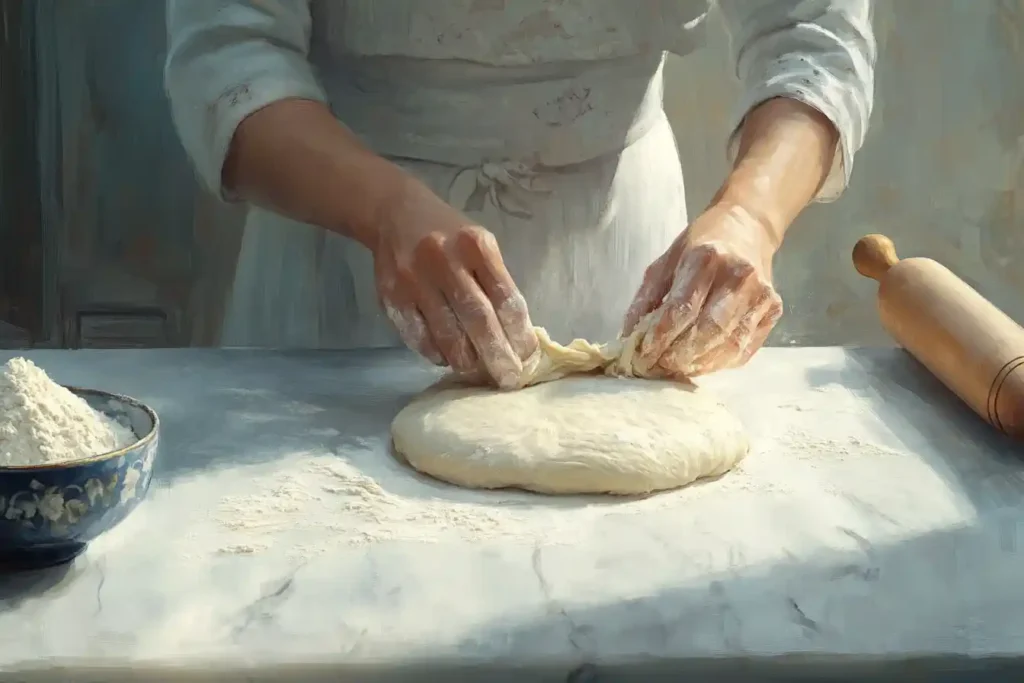Introduction and Identifying the Problem
Understanding the Causes of Dry Cinnamon Rolls
Soft, pillowy cinnamon rolls that melt in your mouth don’t happen by accident. It all starts with understanding what can go wrong. When you bite into a cinnamon roll and find it dry, it’s usually because of a few common culprits.
First off, using the wrong flour can throw off your dough’s structure. All-purpose flour has less protein, meaning less gluten, which results in a dough that isn’t as elastic or tender. Bread flour, on the other hand, adds that much-needed strength and softness.
Another issue? Incorrect proofing. Proofing is when the dough rises before baking, and doing it for too long (or too little) will mess with the dough’s moisture. Underproofed dough doesn’t rise enough, while overproofed dough collapses and dries out during baking.
Then there’s the problem of moisture balance. If the dough is too dry, it can’t trap steam when baked—and steam is what makes those layers soft and fluffy. Even the filling can play a role. Too little butter or an imbalance of cinnamon sugar will dry out the inside before the dough finishes cooking.
And don’t forget oven mistakes! Many bakers unknowingly use the wrong oven settings or bake their rolls for too long. High heat can turn even the best dough into dry, hard spirals.
Finally, what happens after baking matters just as much. Cinnamon rolls need careful storage to stay soft after they cool. If left uncovered, they lose moisture fast.
Understanding these common mistakes is the first step toward making moist, bakery-worthy cinnamon rolls that you’ll crave again and again.
Techniques for Moist Cinnamon Rolls
To keep cinnamon rolls from drying out, it’s important to start with the right foundation: your ingredients and preparation techniques. When you use quality ingredients and pay attention to the dough’s texture and proofing, you’re already halfway to success.
Selecting the Right Ingredients
It’s no exaggeration—the right ingredients can make or break your cinnamon rolls. A perfect dough starts with components that promote structure and retain moisture. Let’s break it down:
1. Importance of High-Protein Bread Flour for Structure and Softness
Bread flour, with its higher protein content, creates a stronger gluten network, helping the dough stay elastic and tender. If you swap in low-protein flours like cake flour or regular all-purpose flour, you risk ending up with rolls that are too crumbly. Gluten gives the dough its stretch and traps moisture during baking, resulting in those soft, pillow-like rolls.
2. Role of Fat in Dough Moisture
Ah, butter—what’s a cinnamon roll without it? Fat from butter, cream, and eggs enriches the dough, adding tenderness and richness. Butter locks in moisture while giving that signature flavor, and eggs act as a binding agent that keeps the dough soft and fluffy. And hey, don’t skimp on the butter in your filling, either! More butter equals a gooier center that balances the dough’s texture.
3. Choosing Fresh Yeast vs. Instant Dry Yeast
Yeast makes your cinnamon rolls rise, but did you know the type you choose affects the moisture too? Fresh yeast often gives a deeper, more complex flavor, while instant dry yeast is reliable and quicker to work with. However, be sure your yeast is active—expired or improperly stored yeast can lead to under-risen dough that feels dense and dry.
4. Adding Milk or Buttermilk for Enriched Dough
Water is common in basic dough recipes, but if you swap it out for whole milk or buttermilk, you’re adding extra fat and tangy moisture that elevates the flavor. Buttermilk’s slight acidity also helps tenderize the dough, creating that delicate crumb that melts in your mouth.
Proper Dough Preparation Techniques

The best ingredients won’t mean a thing if the dough isn’t mixed or kneaded properly. There’s a fine line between developing enough gluten for elasticity and overworking the dough, which can lead to toughness.
1. Mixing Techniques to Avoid Overworking the Dough
Mix just until the dough comes together and is slightly sticky. Overmixing—especially with a stand mixer—can heat the dough, causing gluten to tighten and making the dough tough.
2. How to Knead to Ensure Elasticity Without Toughness
Use the “stretch and fold” method for kneading instead of aggressive rolling. Gently stretch the dough, fold it over itself, and repeat. This method builds strength while preserving softness, giving the rolls that coveted chewiness without making them dense.
3. Proper Dough Hydration Levels
A sticky dough isn’t your enemy—it’s actually a sign of proper hydration. Aim for a dough that sticks slightly to your fingers but doesn’t leave large clumps. Too much flour dries the dough, while too much liquid can make it too slack and impossible to shape.
Optimal Proofing Methods
Proofing is where the magic happens, but it’s also where things can go sideways fast. Too little proofing leads to dense dough, while too much leads to collapse. Here’s how to get it just right:
1. First Proofing (Bulk Fermentation) Guidelines: Timing and Temperature
After kneading, the dough needs time to rest and rise. Ideally, proof the dough for 1 to 2 hours at room temperature (around 75°F). The dough should double in size but not over-expand.
2. Second Proofing After Shaping: When Is It Enough?
Once the dough is rolled and cut into spirals, the second rise is shorter—about 30 to 45 minutes. The dough should puff up slightly but hold its shape. You want the rolls to be airy, not deflated.
3. How to Avoid Overproofing, Which Can Dry Out the Dough
Overproofed dough stretches the gluten too thin, causing it to collapse and dry out during baking. To avoid this, check the dough by gently pressing it—if it springs back slowly, it’s ready. If it deflates quickly, it’s been proofed too long.
4. Best Ways to Create a Warm, Moist Environment
Cinnamon roll dough loves a cozy space to rise. Cover the bowl with a damp towel or plastic wrap to trap steam. Alternatively, preheat your oven for a few minutes, turn it off, and proof your dough inside for a consistent, warm environment without drafts.
Baking Tips and Post-Baking Care
Choosing the Appropriate Baking Equipment
Believe it or not, the right baking equipment can make a world of difference. Some pans conduct heat more evenly, while others can cause uneven baking, leading to dry edges.
1. Benefits of Using Glass or Ceramic Baking Dishes for Even Heat Distribution
Glass and ceramic baking dishes hold heat better than metal pans, which helps the cinnamon rolls bake evenly. Unlike thin metal pans that can heat up too quickly, glass or ceramic provides steady heat, ensuring the middle of the rolls bakes without drying out the edges.
2. Importance of Parchment Paper for Preventing the Bottoms from Drying Out
Lining your baking dish with parchment paper creates a barrier that keeps the bottoms from sticking and drying out. Plus, parchment helps with easy cleanup—no more scrubbing sticky cinnamon-sugar syrup off the pan!
Correct Baking Temperatures and Times
Temperature and timing are critical in achieving that soft, golden-brown roll with a gooey center.
1. Ideal Oven Temperature for Cinnamon Rolls (350°F–375°F)
Baking cinnamon rolls at 350°F to 375°F is the sweet spot. A lower temp allows the dough to bake evenly without overcooking the exterior before the center is done.
2. How to Avoid Overbaking: Visual Cues
The tops of your rolls should be lightly golden brown, not dark. Another trick? Check the internal temperature—it should read around 190°F for perfectly baked rolls.
3. How to Prevent Drying If You Have a Convection Oven
Convection ovens circulate hot air, which can dry out baked goods faster. To counter this, reduce the temperature by 25°F and cover the rolls loosely with foil for part of the bake to lock in moisture.
Enhancing Moisture with Fillings and Toppings
The right filling and toppings do more than add flavor—they help seal in the dough’s moisture.
1. Adding Enough Filling Without Overloading
A good filling should be generous but not oozing out. Stick with a balanced mix of softened butter, brown sugar, and cinnamon for a sweet, sticky center. Adding just enough prevents gaps that can dry out the roll.
2. Role of Cream Cheese Frosting or Glaze in Sealing Moisture
A warm cinnamon roll practically begs for a drizzle of cream cheese frosting or glaze! But this isn’t just for aesthetics—the frosting locks in steam as the rolls cool, preventing the tops from crusting over.
3. When to Add Frosting: Right Out of the Oven vs. After Cooling Slightly
If you frost your cinnamon rolls while they’re still warm, the glaze melts into the layers, creating a luscious coating. Waiting until they’ve cooled slightly keeps the frosting thick and fluffy. Either way, it acts as a delicious moisture shield.
Post-Baking Care to Maintain Softness

Once the cinnamon rolls come out of the oven, they need some post-baking TLC to keep their softness.
1. Covering with Foil or Plastic Wrap Immediately After Cooling
As soon as the rolls reach room temperature, cover them tightly with foil or plastic wrap to trap any remaining steam. This keeps them moist and fluffy for hours.
2. Spraying Rolls Lightly with Milk Before Reheating
If your rolls have started to dry out, a little spritz of milk before reheating works wonders. The moisture from the milk helps rehydrate the dough, especially when paired with a low-temperature reheat.
Storage, Reheating, and Avoiding Common Mistakes
Effective Storage Solutions to Prevent Dryness
Proper storage is key to preventing your cinnamon rolls from becoming dry and stale.
1. Best Methods for Same-Day, Overnight, and Long-Term Storage
To keep rolls fresh for the same day, store them in an airtight container at room temperature. When storing them overnight, wrap them tightly in plastic wrap or foil and place them in the fridge. If you’re planning for longer-term storage, freezing them is your best option.
2. Using Airtight Containers, Plastic Wrap, and Freezer Bags
Airtight containers prevent air exposure, which is the main culprit of dryness. If freezing, wrap each roll individually in plastic wrap, then place them in a freezer-safe bag. This prevents freezer burn and keeps them moist when you thaw them.
3. When and How to Refrigerate or Freeze Cinnamon Rolls
Refrigerate baked cinnamon rolls only if they have a perishable frosting like cream cheese. Unfrosted rolls can stay at room temperature for up to 2 days. If freezing, reheat directly from frozen rather than letting them thaw at room temp, as this helps retain moisture.
Reheating Techniques to Restore Freshness
Reheating can either restore that fresh-from-the-oven softness or make them dry as a desert—it all depends on the method.
1. Microwave Method: Using Damp Paper Towels
Place a damp paper towel over the cinnamon roll and microwave for 15–20 seconds. The steam from the towel prevents the roll from drying out as it reheats.
2. Oven Method: Covering with Foil and Using a Low Temp
Wrap the roll in foil and bake at 300°F for 8–10 minutes. This slow, gentle method warms the roll without overcooking it.
3. How to Avoid Over-Reheating
Whether using the microwave or oven, don’t leave your rolls unattended. A few extra seconds can zap out all the moisture. Check frequently to avoid a disappointing, dry result.
Common Mistakes Leading to Dry Cinnamon Rolls and How to Avoid Them
Even experienced bakers can make mistakes that lead to dry cinnamon rolls, but knowing these pitfalls can help you avoid them.
1. Adding Too Much Flour During Kneading
It’s tempting to keep dusting flour on sticky dough, but too much flour leads to tough, dry rolls. Instead, use just a light dusting and rely on kneading to bring the dough together.
2. Skipping the Enriched Dough Ingredients (Butter, Eggs)
Butter, eggs, and milk aren’t just for flavor—they’re essential for moisture. Skipping these to make “healthier” rolls can leave you with a dry, crumbly dough.
3. Proofing for Too Long or Not Long Enough
Underproofed dough doesn’t rise enough to trap steam, while overproofed dough becomes weak and deflates during baking. Proof until the dough just doubles—not more, not less.
4. Forgetting to Preheat the Oven or Opening the Oven Too Frequently
An oven that isn’t fully preheated won’t bake the rolls evenly, while opening the door too often releases hot air, causing uneven baking. Both mistakes can dry out your cinnamon rolls before they’re ready.
Nutritional Content of Cinnamon Rolls (Per 100g)
| Nutrient | Amount (Per 100g) |
|---|---|
| Calories | 350 kcal |
| Total Fat | 15 g |
| Saturated Fat | 9 g |
| Carbohydrates | 50 g |
| Sugar | 24 g |
| Protein | 6 g |
| Sodium | 300 mg |
| Fiber | 1.2 g |
Frequently Asked Questions
Why do my cinnamon rolls turn out dry even when I follow the recipe?
Even if you’re following the recipe closely, small details can throw off the moisture level. Underhydrated dough, using too much flour, or baking for too long can all lead to dry cinnamon rolls. Also, double-check your oven’s actual temperature—some ovens run hotter or cooler than expected, which can affect the bake.
Can I use a different type of flour to make my cinnamon rolls softer?
Yes! Bread flour is recommended because it has more gluten, which helps with structure and softness. All-purpose flour works too, though the texture may be slightly less chewy. Cake flour, on the other hand, has less protein, which can make the rolls tender but more prone to crumbling.
How can I store cinnamon rolls overnight without them drying out?
To keep cinnamon rolls soft overnight, wrap them tightly in plastic wrap or aluminum foil and store them at room temperature. If they have perishable frosting (like cream cheese), refrigerate them in an airtight container and reheat carefully the next day to avoid dryness.
Is it better to frost cinnamon rolls before or after baking to keep them moist?
Typically, frosting after baking is the best way to keep cinnamon rolls moist. The warm rolls help the frosting melt slightly, creating a seal that locks in moisture. However, some recipes suggest pouring cream or frosting on the rolls halfway through baking for an ultra-soft, gooey finish.
Conclusion
Making soft, moist cinnamon rolls isn’t as complicated as it may seem—it’s all about the right combination of ingredients, proofing, baking, and storage techniques. By understanding the most common pitfalls, like using too much flour or overproofing, you can avoid dry rolls and bake perfect ones every time.
Finally, don’t be afraid to experiment with enriched dough, fillings, and reheating tricks. With practice and attention to detail, you’ll be serving up irresistibly gooey, bakery-level cinnamon rolls that stay fresh for days. So, preheat that oven, grab your butter, and get ready for your softest batch yet!
For more inspiration and creative ideas, don’t miss our latest article:”Difference between Chelsea buns and cinnamon rolls“. It’s packed with fresh recipes and tips to make your cooking experience even more enjoyable!
For more inspiration and creative ideas, don’t miss our latest article:”secret to making moist muffins“. It’s packed with fresh recipes and tips to make your cooking experience even more enjoyable!”
For more inspiration and creative ideas, don’t miss our latest article:”heavy cream on cinnamon rolls before baking“. It’s packed with fresh recipes and tips to make your cooking experience even more enjoyable!”

